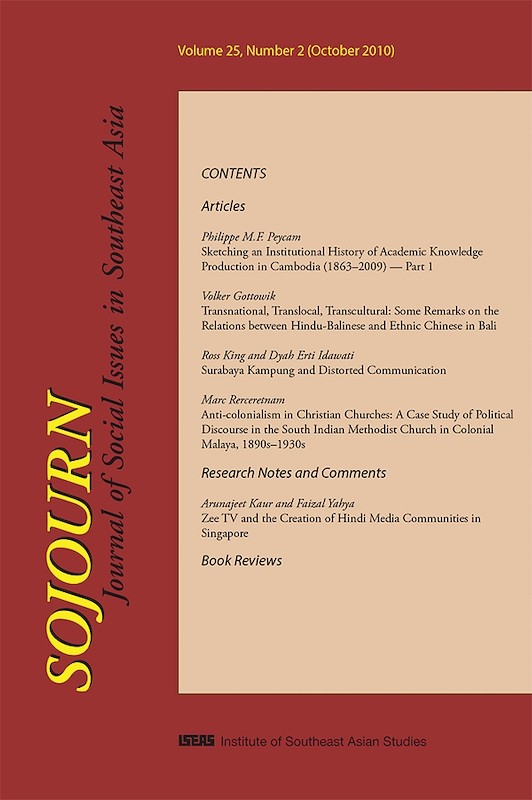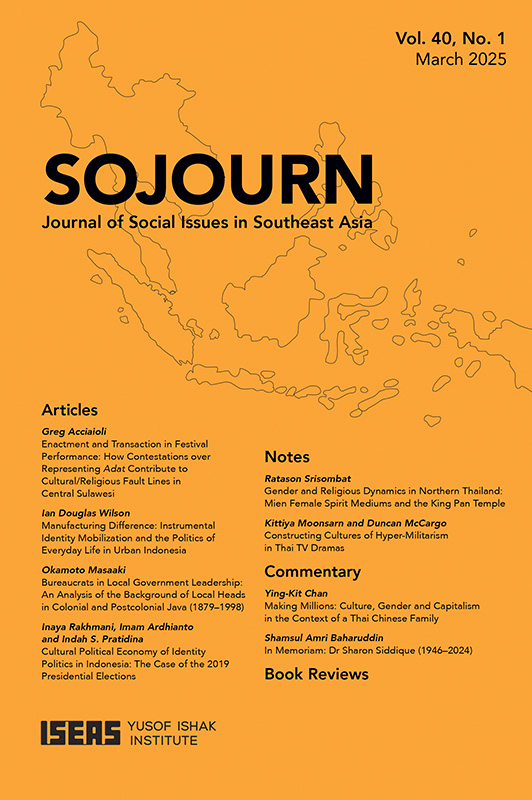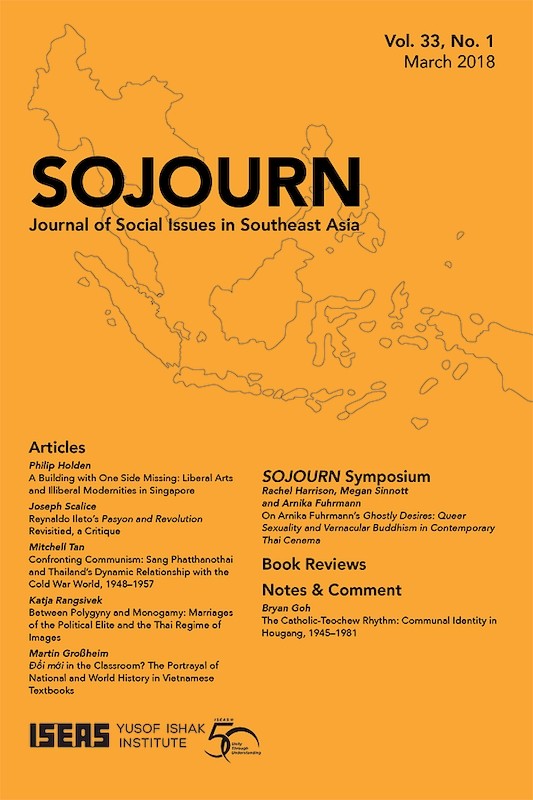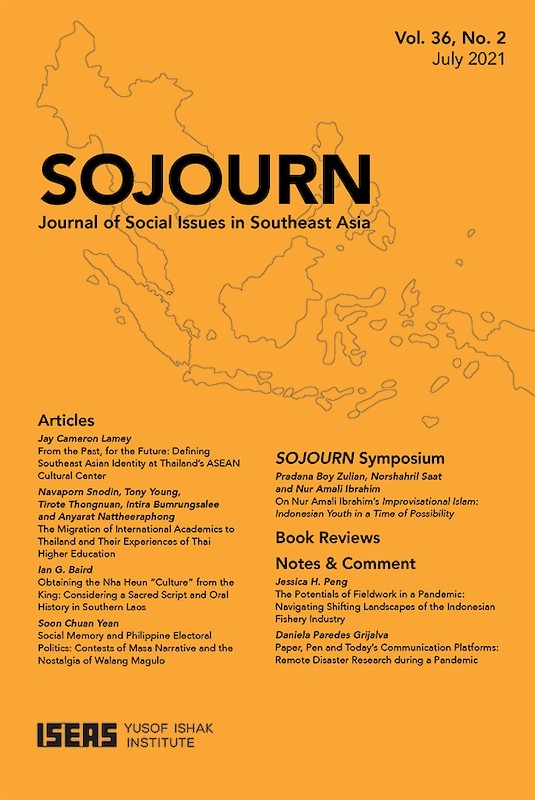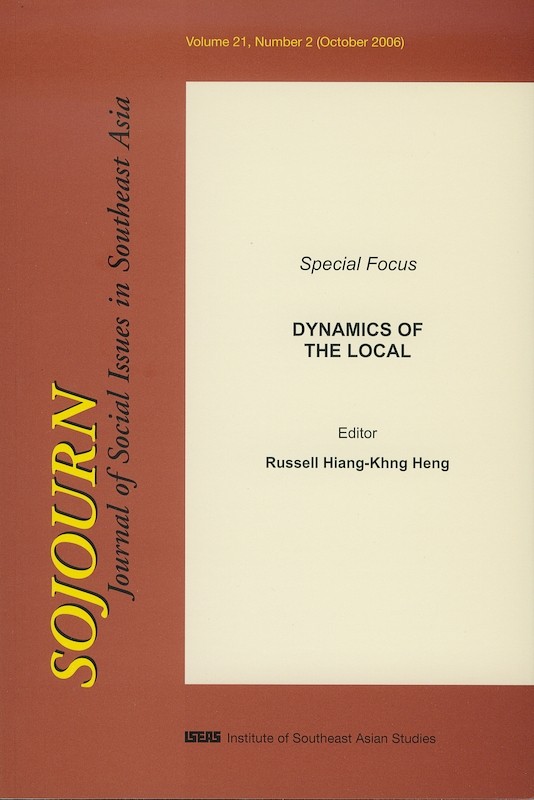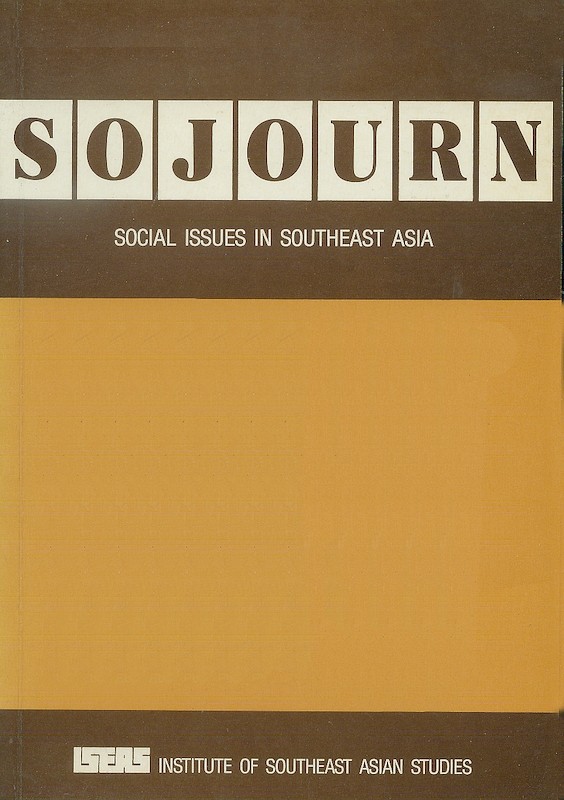SOJOURN: Journal of Social Issues in Southeast Asia Vol. 16/1 (Apr 2001)
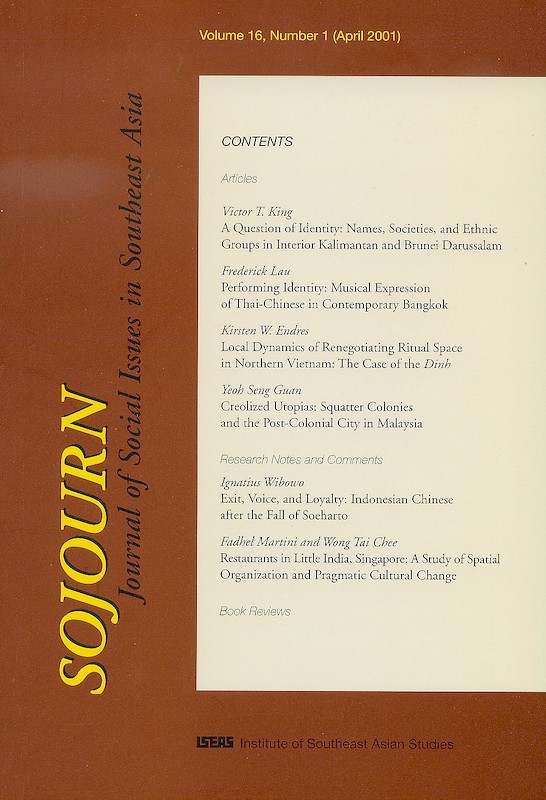
Date of publication:
June 2001
Publisher:
Institute of Southeast Asian Studies
Number of pages:
178
Code:
SJ16/1
Contents
-
Preliminary pages
- ARTICLES
-
A Question of Identity: Names, Societies, and Ethnic Groups in Interior Kalimantan and Brunei Darussalam, by Victor T King, author see abstractIssues of ethnic identity and nomenclature loom large in the recent anthropological literature on Borneo. The difficulties of delineating and naming ethnic categories and groups can be aptly illustrated in two recent debates: one on the nature of traditional "Maloh" society in the Upper Kapuas region of West Kalimantan and the appropriateness of the ethnic label "Maloh", and the other on the definition and characterization of Brunei society. The two cases demonstrate that some of our difficulties arise from the tendency to assume that ethnic categories and groups should be defined on the basis of both shared cultural features and a distinctive social system which persist through time. Instead, our understanding of the dynamics of identity formation and processes of social change can be enhanced by rethinking the concept of society or social system so that ethnic groupings are seen as constituent parts of wider sets of social, economic, political, and cultural relations. Despite the different historical experiences of the Upper Kapuas region and the Brunei sultanate, the parallels between the two cases are striking. They indicate the importance of examining the ways in which Malay political centres have served as nodal points in the articulation of both cultural identities and social models of equality and hierarchy in multiethnic situations.
-
Performing Identity: Musical Expression of Thai-Chinese in Contemporary Bangkok, by Frederick Lau, author see abstractThe study of Chinese communities in Southeast Asia has mostly emphasized their impact on economic and political arenas. By privileging cultural practices as viable loci for investigation, this paper focuses on music as a site for the exploration of identity formation and notion of Chineseness. Based on ethnomusicological fieldwork conducted amongst Teochew-Chinese in Bangkok, this paper utilizes analysis of amateur Teochew music clubs to illustrate how identity, both cultural and political, is always a hybridized performance that is shaped as much by subjective interpretations of history and essentialized notions of homeland as by the politics of the historical moment.
-
Local Dynamics of Renegotiating Ritual Space in Northern Vietnam: The Case of the Dinh, by Kirsten W Endres, author see abstractBefore the revolution swept through the villages of Northern Vietnam, the village communal house (dinh) was the centre of male-dominated power and the place where the status hierarchy of village society was ritually reproduced. With the advent of the revolution, the dinh became a major target of socialist ritual reform aimed at building a new egalitarian and just society. This paper looks at the failures and attainments of ritual reforms, and the various local dynamics of negotiating and restructuring ritual space and practices in different periods of recent Vietnamese history.
-
Creolized Utopias: Squatter Colonies and the Post-Colonial City in Malaysia, by Yeoh Seng Guan, author see abstractIn an early formulation put forward by Robert Redfield and Milton Singer, a distinction was made between cities that engendered "orthogenetic" and "heterogenetic" cultural transformations. "Orthogenetic cities" are associated with earlier forms of urbanism which were primarily ceremonial and literate centres that progressively refined "little traditions" into more sophisticated "great traditions". In contrast, "heterogenetic cities" are akin to present-day administrative and business cities, which are prone to transform old cultures and traditions. Drawing from the notion of "creolization" advanced by Ulf Hannerz, this paper argues for a modified position between these two axes. I suggest that whilst various town planning traditions and urban aesthetics inherited from the colonial past continue to be hegemonic in post-colonial Malaysia, the changed economic and social conditions, nevertheless, allow for a degree of cultural hybridization vis-a-vis cultural homogenization. Indeed, the keen contest over development and culture is particularly well indexed in the cultural site of the "post-colonial city".
- RESEARCH NOTES AND COMMENTS
-
Exit, Voice, and Loyalty: Indonesian Chinese after the Fall of Soeharto, by Ignatius Wibowo, author see abstractThe May Riots in 1998 (May Riots) in Jakarta and other cities in Indonesia induced the Chinese to act. Using Albert Hirschman's theoretical framework, three types of responses are detected: "exit", "voice", and "loyalty". This study shows that although quite a number of Chinese chose "exit", the majority of them chose either "voice" or "loyalty". Indeed, those who chose "loyalty" probably constituted the vast majority. This being the case, it is fairer to observe the behaviour of the Chinese after the fall of Soeharto more in terms of those who are "loyal" than to those who "exit".
-
Restaurants in Little India, Singapore: A Study of Spatial Organization and Pragmatic Cultural Change, by Fadhel Martini, Wong Tai Chee, authors see abstractFood is not culturally neutral but strongly associated with identity, prestige, social place, and symbolic meanings. In Singapore's Little India, food has been commercialized as a public good of consumption, integral of a broadly defined ethnic Indian identity and representation. Over the years, within the spatial setting of Little India, the ethnic Indian cuisine has been adapted for rapid change in new environments. These include the impacts of the government's policy to use it to promote multiculturalism, the Urban Redevelopment Authority's earmarking of Little India as a conservation area in 1989, and the Singapore Tourism Board's campaign to attract international tourists. For restaurant operators, it is the pragmatic business adaptation and cuisine hybridization that is most essential for survival. Consequently, the outcome of this process of accommodating change has produced a new breed of cityscape in a systematically identified zone of the increasingly cosmopolitan Singapore.
- BOOK REVIEW
-
BOOK REVIEW: Staying Local in the Global Village: Bali in the Twentieth Century. Edited by Linda H. Connor and Raechelle Rubinstein, by George Aditjondro, author
-
BOOK REVIEW: Endangered Relations: Negotiating Sex and AIDS in Thailand. By Chris Lyttleton, by Philip Guest, author
-
BOOK REVIEW: Indonesia Beyond Suharto: Polity, Economy, Society, Transition. Edited by Donald K. Emmerson, by Anthony L Smith, author
-
BOOK REVIEW: The Poetic Power of Place: Comparative Perspectives on Austronesian Ideas of Locality. Edited by James J. Fox, by Victor T King, author

